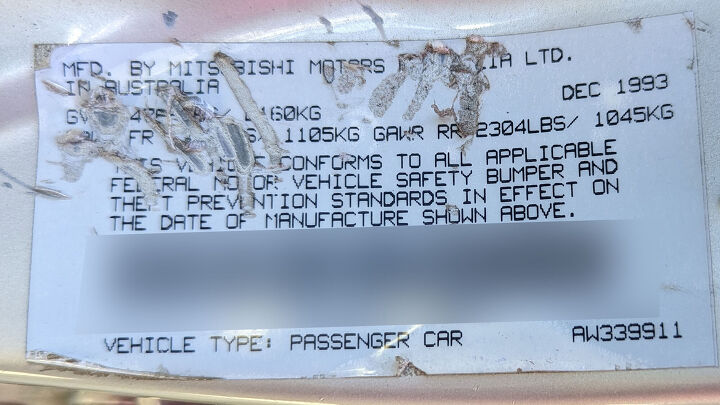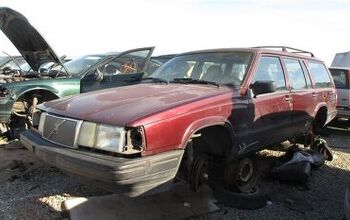Junkyard Find: 1994 Mitsubishi Diamante Wagon

Station wagons were falling out of favor in a hurry with American car shoppers as the 1990s progressed, especially after the 1991 Ford Explorer and 1993 Jeep Grand Cherokee hit showrooms and put the hammer down on the truckification of our roads. Mitsubishi didn't seem to worry about such trends, though, and a longroof version of the Diamante luxury sedan appeared here for the 1993 model year. Here's one of those extremely rare wagons, found in a Northern California car graveyard a couple of months back.
I visit a lot of junkyards, and this is the first Diamante wagon I'd spotted since I ran across a '95 back in 2015.
Mitsubishi built plenty of Colt wagons for Chrysler, and the North American version of the Delica passenger van was called a wagon by Mitsubishi Motors North America. If you require a properly big station wagon with Mitsubishi badges, though, this is the one.
The sedan version of the Diamante was built in Japan, but the wagons came from Australia.
This one got fairly close to 200,000 miles during its life.
It appears to have been well cared for during its 29-year career. The body and interior look good and the original owner's manual was still in the glovebox.
The top-level Diamante LS sedan got a 202-horse DOHC version of the versatile 6G72 V6 engine, but the ES sedan and wagon got this SOHC 6G72 with 175 horsepower.
Mitsubishi built Diamantes with four-wheel-drive and manual transmissions, but those were never sold here. North American Diamantes all got front-wheel-drive and automatics.
The Diamante sedan was cheaper than the rest of the Japanese luxury sedan competition (including the quite affordable Mazda 929, in its second-to-last model year in 1994). It was the only big Japanese luxury wagon sold here during its time.
The MSRP on this wagon was $25,850, or about $53,773 in 2023 dollars.
Toyota gave up on the Cressida wagon here after 1987, while Nissan stopped selling Maxima wagons the following year. Toyota offered the Camry wagon all the way through 1996, but that car just couldn't measure up to the Diamante wagon's opulence.
It didn't matter. Few Americans bought Diamante sedans, and even fewer went for the Diamante wagon. 1995 was the last year for the Diamante wagon here.
Mitsubishi put AUX jacks on many of its factory radios during the 1990s, thanks to the Mini-Disc boom in Japan during that decade. You can also find AUX jacks on some U.S.-market 1990-1991 Subaru Legacy radios; just about everyone else waited until the mid-to-late 2000s to include this useful feature. Yes, I bought this radio for a car-parts boombox project.
Here's an advertisement from the Diamante wagon's homeland.
[Images: Author]
Become a TTAC insider. Get the latest news, features, TTAC takes, and everything else that gets to the truth about cars first by subscribing to our newsletter.

Murilee Martin is the pen name of Phil Greden, a writer who has lived in Minnesota, California, Georgia and (now) Colorado. He has toiled at copywriting, technical writing, junkmail writing, fiction writing and now automotive writing. He has owned many terrible vehicles and some good ones. He spends a great deal of time in self-service junkyards. These days, he writes for publications including Autoweek, Autoblog, Hagerty, The Truth About Cars and Capital One.
More by Murilee Martin
Latest Car Reviews
Read moreLatest Product Reviews
Read moreRecent Comments
- Jalop1991 This is easy. The CX-5 is gawdawful uncomfortable.
- Aaron This is literally my junkyard for my 2001 Chevy Tracker, 1998 Volvo S70, and 2002 Toyota Camry. Glad you could visit!
- Lou_BC Let me see. Humans are fallible. They can be very greedy. Politicians sell to the highest bidder. What could go wrong?
- SPPPP Vibrant color 9 times out of 10 for me. There may be a few shapes that look just right in metallic gray, for example. There are a few nices ones out there. And I like VW "White Silver". But I'd usually prefer a deep red or a vibrant metallic green. Or a bright blue.
- 28-Cars-Later Say it ain't so, so reboot #6* isn't going to change anything?[list=1][*]V4-6-8 and High "Tech" 4100.[/*][*]Front wheel drive sooooo modern.[/*][*]NOrthSTARt.[/*][*]Catera wooooo.[/*][*]ATS all the things.[/*][*]We're *are* your daddy's Tesla. [/*][/list=1]













































Comments
Join the conversation
Mitsu was in full stride at this time. Growing the line above the Galant and giving Toyota and Nissan a run for its money. However, it dithered on its next step (V6 for Galant, replacement for Diamante, God awful styling). Then the Koreans ate their lunch.
Who ever thought an equalizer was a good idea for a car must not have driven much.